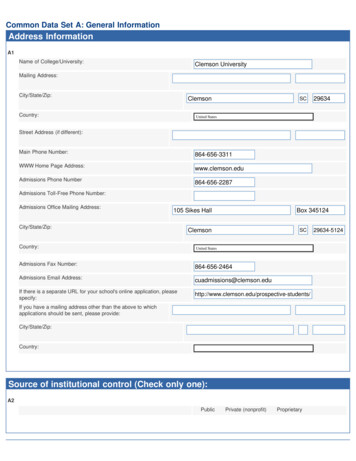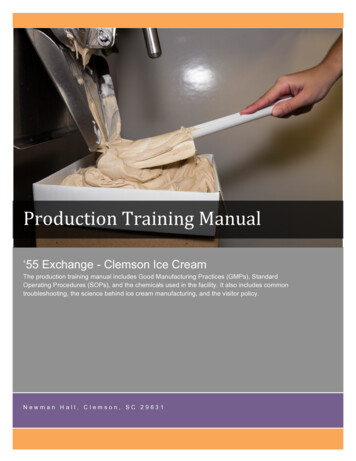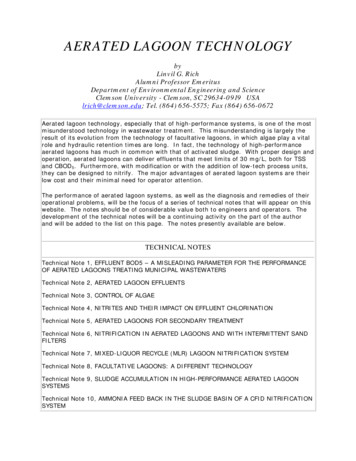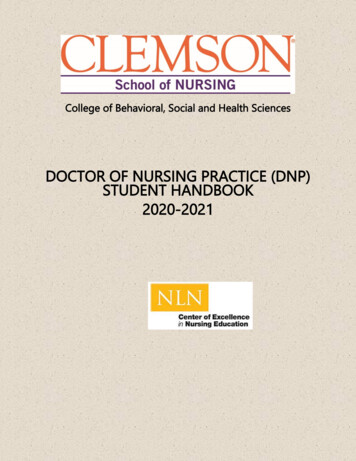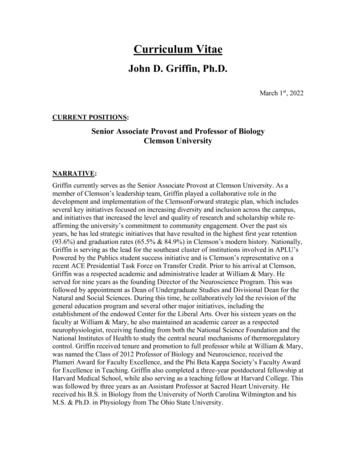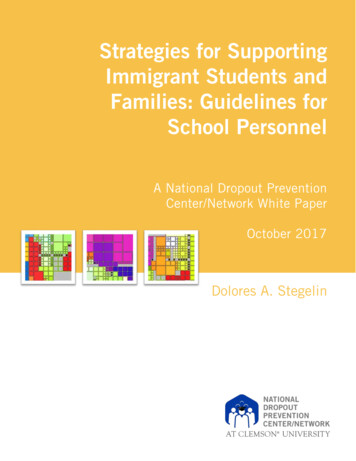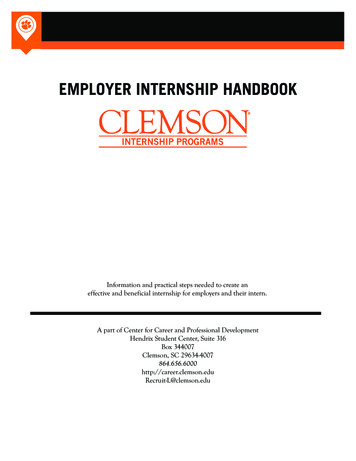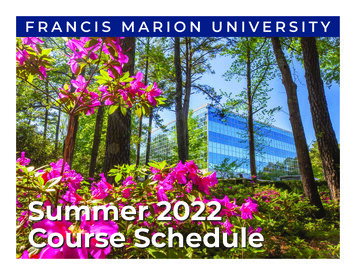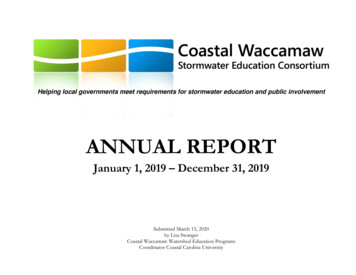
Transcription
Helping local governments meet requirements for stormwater education and public involvementANNUAL REPORTJanuary 1, 2019 – December 31, 2019Submitted March 15, 2020by Lisa SwangerCoastal Waccamaw Watershed Education ProgramsCoordinator Coastal Carolina University
TABLE OF CONTENTS2019 ACTIVITY TOTALS SUMMARY. 1EXECUTIVE SUMMARY.History .Goals and Strategies .Core Education Providers .Member SMS4s .CWSEC Role with NPDES Phase II Permit.CWSEC Planning Process Flowchart .22345892019 ACTIVITY HIGHLIGHTS . 10CONCLUSION . 18APPENDIX A . 192019 Activity Plan . 19APPENDIX B . 252019 Database Log (January 1 – December 31, 2019) . 25APPENDIX C. . 34Water Quality Monitoring. . 34CWSEC Annual Report January 1, 2019 – December 31, 2019
2019 ACTIVITY TOTALS SUMMARYMinimum Control Measure #1: Public Education and OutreachOutreach StrategyBrochures/Informational Cards/Booklets# Distributed /Reached1,619Outreach StrategyNewsletters# Distributed /Reached55,295Websites155,524Online Coverage264,000Newspaper Articles354,600Television (PSAs & News 563BillboardsEducational SignageWorkshops/SeminarsField Workshop/Field Trip224,99302931,425Television / Online Coverage (Promotingtools, resources, positive behaviors)Giveaways with Stormwater MessagePet Waste ContestPresentationsConference HostingGood Housekeeping Video Viewing215520LID Manual2,427Technical Assistance via MeetingParticipationSocial Media1,2251001,17928863,879Minimum Control Measure #2: Public Involvement/ParticipationActivityRiver, Marsh and Beach Cleanups# of# ofActivities Participants1961,385Pet Waste Stations inMurrells InletStorm Drain Marking6 sites8,200 bags7209RIVERKEEPER Challenge376Secchi Dip-In Turbidity Monitoring onWaccamaw River and CCU campus42100ActivityVolunteer Water Quality Monitoring inSurfside BeachVolunteer Water Quality Monitoring inMurrells InletVolunteer Water Quality Monitoring onWaccamaw RiverVolunteer Water Quality Monitoring atCCUVolunteer Water Quality Monitoring inBriarcliffe AcresCWSEC Annual Report January 1, 2019 – December 31, 2019# ofActivities46# ofParticipants1381843584141,1504914057285Page 1
EXECUTIVE SUMMARYHistoryFrom its conception in May 2004, the Coastal WaccamawStormwater Education Consortium (CWSEC) set out to fulfill newfederal Clean Water Act requirements associated with the NationalPollutant Discharge Elimination System (NPDES) Phase IIStormwater Program. Six small municipal separate storm sewersystems (SMS4s) located within the Myrtle Beach Urbanized Area(MBUA) unanimously endorsed a coordinated approach to regionalstormwater education. They charged the educational serviceproviders with developing a Regional Stormwater EducationStrategy and a Phased Education Work Plan based on a formalneeds assessment. This can be found at dance/1104 phased education work plan.pdf.strategies. CWSEC members approved the changes in June 2011(refer to page 3). The education providers continue to coordinate,communicate and involve each SMS4 to serve each of their needsfor Minimum Control Measures (MCM) #1 and #2 for publicoutreach and engagement.Figure 1 - Map of CWSEC SMS4sThe Consortium’s first staff member, Karen Fuss, began work inOctober 2005 and became the first CWSEC Coordinator in summer2006. In November 2014, Lisa Swanger assumed the Coordinatorrole which serves as a central point of contact to better coordinatecommunication amongst the SMS4s and education providers.Based on guidance from South Carolina Department of Health andEnvironmental Control (SCDHEC) staff in March 2007, CWSECmembers and educators chose to focus educational messages onthose pollutants contributing to 303(d) impaired waters listings. Latein 2007, the Towns of Atlantic Beach and Briarcliffe Acres signedresolutions to join CWSEC. A second needs assessment inDecember 2009 aimed to guide future educational programmingduring the second 5-year NPDES Phase II permit cycle. Thefindings stressed the unique needs and priorities that vary amongSMS4s and their target audiences. The education providers thenparticipated in strategic planning sessions and updated the goals andCWSEC Annual Report January 1, 2019 – December 31, 2019Page 2
Goals and Strategies (Approved June 2011)1.) Maximize efficiency and effectiveness through coordinatedand collaborative stormwater education activities. Efforts are collaborative, synergistic and non-duplicative Work, plan and report together as an entity – memberSMS4s and education providers Adaptive management in which assessment results areused to guide improved implementation Identify and maximize use of individual organizationalstrengths Be a cost-effective deliverer of educational services Support the needs and goals of core education providers2.) Using a regional watershed approach, help member SMS4smeet NPDES Phase II stormwater permit requirements forpublic education and outreach and publicinvolvement/participation. Deliver public education and involvement activities thataddress water quality information Work, plan and report together as an entity – memberSMS4s and education providers Tailor support activities to individual member SMS4sneeds Recognize the changing needs of member SMS4s andevolving regulatory requirements within the region3.) Provide and exchange technical information and expertiseon innovative stormwater best management practices andsupporting funding opportunities. Serve as an information provider on technical andcurrent innovations and associated environmentalconditions Keep current on educational theory/behaviorchange/social research/effective communicationtechniquesMake local educational resources and service providersreadily accessibleSupport identification of external funding opportunities,proposal development, and project delivery4.) Improve watershed and stormwater awareness in targetaudiences that informs decision-making and promotesbehavior change to address water quality impairments. Define target audiences to address water quality threatsand impairments Use programming in which increased awareness and/orbehavior change is measurable Stormwater education efforts by public/municipalitiesare shifted to a watershed focus Empower population to serve as stewards of theirwatersheds through delivery of messages and takingaction5.) Continue to serve as a model for collaborative stormwatereducation and involvement throughout the state of SC andbeyond. Communicate outreach efforts and success storiesbeyond the Consortium and target audiences Build upon Consortium collaboration and successes tosecure future grantsCWSEC Annual Report January 1, 2019 – December 31, 2019Page 3
Core Education ProvidersCoastal Carolina University’s Waccamaw Watershed AcademyLisa Swanger, Coastal Waccamaw Watershed Education Programs CoordinatorDr. Susan Libes, Director of WWA and Professor of Marine Science and ChemistryVictoria Green, Volunteer Water Quality Monitoring CoordinatorKelly Hall, Assistant Volunteer Water Quality Monitoring CoordinatorClemson Extension’s Carolina Clear ProgramKim Counts-Morganello, Clemson Extension’s Carolina Clear Program CoordinatorMurrells Inlet 2020Meredith Harrison, Executive DirectorNorth Inlet – Winyah Bay National Estuarine Research ReserveBeth Thomas, Education CoordinatorHayley Fournier, Education SpecialistMaeve Snyder, Coastal Training Program CoordinatorSouth Carolina Sea Grant ConsortiumApril Turner, Coastal Communities SpecialistWinyah Rivers Alliance Waccamaw RIVERKEEPER ProgramCara Schildtknecht, Waccamaw RiverkeeperCWSEC Annual Report January 1, 2019 – December 31, 2019Page 4
Member SMS4sSMS4 ContactsSMS4 Annual Priorities and ProjectsThe Town of Atlantic Beach is focused on reducing litter entering their stormwatersystem, particularly during Town events. Atlantic Beach is also undertaking an effort toidentify locations of septic systems within the Town to determine whether any systemsare failing and could connect to sewers.Benjamin Quattlebaum, Town Managerhttp://townofatlanticbeachsc.comBrian Palliser, Town Councilman andStormwater/Lake Committee Memberhttp://www.townofbriarcliffe.us/Kevin Chestnut, Director of Public cworks/Briarcliffe Acres’ stormwater focus is on their recently established (February 2019)water quality testing program coordinated by CCU and Town Council, as well asmaking improvements to stormwater runoff throughout the town. The Town is alsocontinuing to work with neighboring municipalities to keep White Point Swash at itsnatural location while maintaining adequate tidal flushing of the tidal estuary. Anongoing focus will continue to be directed towards the water quality testing program toobserve changes and trends within White Point Swash. The Town continues toeducate their residents by raising awareness on how to properly maintain septicsystems.Conway’s Water Quality and Drainage Commission includes 4 members, with the Cityactively looking to fill 3 open positions, serving for 3-year terms. The City seeks to addbusinesses into the River-Friendly Business Program, implemented to help reduce theenvironmental impact on the Waccamaw River and the community, and to recognizeeach business for their commitment and participation. Program materials are at:http://www.cityofconway.com/departments/public works/riverfriendly business program overview.php. The City has also continued to support theWaccamaw Riverkeeper’s River Sweeps, the Waccamaw River Volunteer Water QualityMonitoring Program, restoration of the Crabtree Canal, and has instituted astormwater inspection program.CWSEC Annual Report January 1, 2019 – December 31, 2019Page 5
Ray Funnye, Director of Public Services;Tracy Jones, Stormwater Division Manager;Danielle Turner, Billing Coordinator;Chris Hancock, Stormwater nwater.com/Tom Garigen, Stormwater Manager;Thom Roth, Deputy Stormwater Manager;Chelsea Cogliano, Watershed Plannerhttp://stormwater.horrycounty.orgJanet Curry, Director of Public Works;Eric Norris, Street Division Superintendent;Georgetown County Stormwater Division’s mission is to protect and improve thequality of life of all citizens of Georgetown County and surrounding communities, andprovide for the collection and conveyance of stormwater runoff in accordance with allfederal, state, and local regulations in the safest, most efficient, and cost-effectivemanner possible. The Stormwater Management Plan is designed to reduce thedischarge of pollutants from Georgetown County’s SMS4 to the maximum extentpracticable, protect water quality, and satisfy the appropriate requirements of the CleanWater Act. They also engage in promoting equitable, acceptable, and legal measures forstormwater management. New development continued to grow throughout the countyin 2019. The Stormwater Division is collaborating with MI 2020 again after beingawarded with a 319 Grant for Water Quality Improvements. Design began spring of2019. Major outfalls are being installed along Hagley Drive in Pawley’s that willimprove drainage for the Hagley Estates Community. Several designs are in progressfor outfall improvements along the Waccamaw Neck Corridor that will also provideflooding relief upon construction.Horry County Stormwater Management is continuously working to implement theprovisions of the SMS4 stormwater permit. Effective July 2017, the Horry CountyStormwater Management Ordinance and Design Manual were both revised, addressingwater quality requirements in the SMS4 permit. Horry County’s program is advised byits 11-member Stormwater Advisory Board. The Department has targeted trainingworkshops for HOAs and participates in other educational opportunities to raiseawareness regarding stormwater runoff. Horry County is a partner in theimplementation of the Hog Inlet-Cherry Grove Watershed Plan, along with CWSECmembers City of North Myrtle Beach and Waccamaw Regional Council ofGovernments. The County continues to be a major contributor to several water qualitymonitoring programs throughout the region.The priorities of the Myrtle Beach stormwater management program are to: protect,maintain, and enhance the health, safety and general welfare of the citizens of the City;decrease the degradation of the beaches; prevent damage to properties from improperdrainage and flooding; and protect drinking water supplies. The City has accomplishedthe initial Withers Watershed Pilot Study and is moving towards its second phase ofthe watershed-based masterplan. This past year, each of the four deep ocean outfallsCWSEC Annual Report January 1, 2019 – December 31, 2019Page 6
Samantha Taylor, Stormwater departments/public works department/index.phpKevin Blayton, City Engineer/Public WorksDirector; Jay Beeson, StormwaterCompliance Manager, Dana Hamilton,Engineering Division Managerhttp://www.nmb.us/Page.aspx?id 33John Adair, Public Works tmlwere cleaned and will remain on a routine inspection and maintenance program. TheStormwater Management Program looks forward to a bright future with the additionof the Yaupon Drainage Project which will alleviate local flooding issues, the design ofa header pipe, as well as the addition of 24th Avenue North deep ocean outfall. TheCity desires to continue mitigating flood hazards and enhancing local water qualitywith focus being placed on watershed-based planning efforts. Continued emphasis onour Fats, Oils and Grease public outreach initiative, non-point source pollutioneducation, and intradepartmental coordination of stormwater best managementpractices will occur during the current permit cycle.North Myrtle Beach conducts continuous water quality monitoring within the coastalwaters, including: ocean water quality at Cherry Grove pier and weekly beach waterquality sampling. This monitoring work allows us to identify and target problem areaswith specific water quality improvement methods, and assess the effectiveness of thosemanagement practices. In addition, the city is working jointly with Horry County andthe Waccamaw Regional Council of Governments to implement a watershedimprovement plan for Hog Inlet / Cherry Grove Marsh. We also fund a joint projectwith Horry County and Town of Briarcliffe Acres for WQ monitoring at White PointMarsh, which includes a camera for swash monitoring lina/whitepointswash/slideshow.htm). Thecity’s Manual of Design, Installation, and Maintenance Requirements for StormwaterManagement Plans is available at: ual for Storm Water Management Plans.pdfThe Town of Surfside Beach’s stormwater focus is on flood prevention, water quality,and public education of coastal issues. Surfside Beach has a Stormwater Committeecomprised of 5 members, each serving four-year terms. The town recently approved aStormwater Utility Fee, to fund various large infrastructure improvements, operationalexpenses, as well as pursuing various grant opportunities. This fee will provide adedicated source of funding for these projects. The 2019 focus was on publiceducation, with information given out on websites and street festivals. This is inaddition to the Town’s volunteer monitoring effort and public education component.CWSEC Annual Report January 1, 2019 – December 31, 2019Page 7
CWSEC Role with NPDES Phase II PermitAuthorized by the Clean Water Act of 1972, the NPDES permit program controls water pollution by regulating the discharge of pollutantsinto waters of the United States. In South Carolina, the SCDHEC administers the NPDES program. EPA’s NPDES Stormwater Phase IIRule establishes a stormwater management program that is intended to improve the nation’s waterways by reducing the quantity of pollutantsthat stormwater picks up and carries into storm sewer systems during storm events. The Phase II Rule defines a stormwater managementprogram for a small MS4 as a program composed of six elements or minimum control measures (MCMs), including: 1) Public Education andOutreach on Stormwater Impacts; 2) Public Participation / Involvement; 3) Illicit Discharge Detection and Elimination; 4) Construction SiteRunoff Control; 5) Post-Construction Stormwater Management in New Development and Redevelopment; and 6) Pollution Prevention /Good Housekeeping for Municipal Operations. The Consortium specifically addresses MCMs #1 and 2.The NPDES General Permit for Storm Water Discharges from Regulated SMS4 went into effect on January 1, 2014 and can be found Environment/docs/Final SMS4 Permit.pdf. For MCM #1, this permit requiresidentification of pollutants of concerns, target audiences, outreach goals and assessment. CWSEC had previously established a program thatcomplies with these requirements, which is demonstrated through the procedural flowchart on the following page (Figure 2) and theformalized annual activity plan. Each year, the activity plan is formulated, discussed, and approved during biannual core education providermeetings (spring and fall) and biannual CWSEC meetings (summer and winter). The status on achieving the current and former year’s plannedactivities is also discussed during these biannual meetings. The approved activity plan is compiled and presented in a Microsoft Excelspreadsheet containing the following information: pollutant of concern; target audience; activity description; MCMs addressed; lead serviceprovider; and geographic target. The partnership between the member SMS4s and educators often continues from the planning stage intoactivity implementation. Once the activity is completed, this information is compiled into a database (http://bccmws.coastal.edu/cwsec/)containing the above information from the activity plan and type of assessment utilized.Public involvement and participation activities led by CWSEC, such as volunteer water quality monitoring, storm drain marking andcommunity cleanups, continue to expand and clearly satisfy the new permit requirements for MCM #2. Additionally, the permit states thateach member SMS4 must ensure that their Stormwater Management Plan (SWMP) is easily accessible to the public. Employing the CWSECwebsite (http://cwsec-sc.org/) with links to each SMS4’s SWMP provides a way to access all the CWSEC SMS4 members’ plans from onecentral location. Several major changes were written into the new permit in other MCMs, such as Total Maximum Daily Load (TMDL)monitoring and implementation, illicit discharge detection and elimination, and construction and post-construction, which will result in SMS4smaking adjustments in their stormwater programs in order to fulfill these new requirements. Some of these may warrant education andoutreach, which can be addressed during activity plan creation when appropriate.CWSEC Annual Report January 1, 2019 – December 31, 2019Page 8
Figure 2 – Flowchart describing collaborative process between education providers and SMS4s guiding theConsortium’s annual activitiesCWSEC Annual Report January 1, 2019 – December 31, 2019Page 9
2019 ACTIVITY HIGHLIGHTSThe Coastal Waccamaw Stormwater Education Consortium’sreporting cycle follows the calendar year for the purposes ofmatching SCDHEC’s permit cycle. Therefore, this report coversthe activities that occurred from January 1, 2019 – December 31,2019. The annual activity plan, approved by CWSEC members inDecember 2018, appears in Appendix A. This contains both thenumber of activities and impacts during 2019. Appendix Bincludes an abbreviated version of the activity database and depictsadditional activities beyond those that were accounted for in theannual activity plan (highlighted in blue). The Consortium’sactivity database (http://bccmws.coastal.edu/cwsec/) provides acomprehensive listing and description for all stormwater-relatedactivities conducted throughout the year. Numerous events,workshops and projects were conducted in 2019. Several notableones are highlighted in the following section.consecutive years of extreme rainfall and storm events throughoutthe region highlighted the need for adaptation in coastal SouthCarolina.This course provided practical skills, knowledge, and resources tointegrate adaptation into planning processes. There were manysteps covered, from using climate science to inform decisions andidentifying community assets to prioritizing solutions. Guestspeakers from South Carolina Sea Grant Consortium, the City ofMyrtle Beach, and the City of Conway shared their experience andexpertise with understanding impacts, assessing vulnerabilities, andimplementing solutions. Roughly 20 participants from a widerange of sectors in coastal South Carolina took part in discussionsand exercises to practice putting these concepts into action.Best Management Practices (BMPs)Adaptation Planning for Coastal CommunitiesFor many coastal communities, changing climate is prompting achange in how communities plan. Sea level rise, increasedfrequency and intensity of storms, and extreme temperatures arepossible climate impacts that threaten coastal areas. Communitiestrying to adapt to shifting conditions often find it is a complexchallenge and are unsure where to begin. However, planning toadapt is increasingly important to sustain communities into thefuture.In late May, the NI-WB NERR Coastal Training Program (CTP)hosted a National Oceanic and Atmospheric Administration(NOAA) Digital Coast training, “Adaptation Planning for CoastalCommunities.” This course was designed for planners, publicworks staff, floodplain managers, hazard mitigation planners,community groups, and coastal resource managers. SeveralImage 1 – Course attendees listen to a series ofpresentations and engage in group discussionsCWSEC Annual Report January 1, 2019 – December 31, 2019Page 10
Stormwater / Watershed Outreach Programs2019 Waccamaw Conference Makes a SplashThe 2019 Waccamaw Conference was perhaps the most successfulto date for this annual public education event. The theme, “TheJourney of Trash: Pollution to Solution,” focused on commonsources and impacts of trash in waterways throughout the WinyahBay watershed and what community members can do to help.Understanding the journey of trash from land-based sources all theway to the ocean helps communities better protect our localwaterways.On February 9th, community members throughout the Winyah Baywatershed gathered at the Horry County Museum for theconference. In attendance were 180 participants representingfamilies, scientists, local experts, professionals, and educators – allbrought together for the purpose of discussing problems, sharingideas, and inspiring one another to take action to prevent trashfrom entering our waterways.LaRocco, Georgetown County Environmental Services Division;Michael Hughes, Horry County Solid Waste Authority; and BoIves, Keep Horry County Beautiful. The interactive session was ahuge success with an engaged audience and captivating panel.Additionally, educational exhibits were placed throughout themuseum. Each offered interactive exhibits demonstrating theirefforts to reduce trash in our waterways and how theirorganizations are impacted by this issue. The annual student postercontest drew entries from students throughout Horry andGeorgetown Counties. There were a total of 62 science and artentries in 2019 – the most submitted in the history of theconference!The success of the event is in part due to the popular theme. Thepartnerships utilized to host the event also helped leverage success.The conference is the collective work of the WaccamawRiverkeeper, North Inlet - Winyah Bay National EstuarineResearch Reserve, Coastal Waccamaw Stormwater EducationConsortium, and Horry County Museum. Each organization isable to draw on its own resources in order to reach a broadercommunity throughout the watershed.The 2019 guest speaker was Dr. Stefanie Whitmire of the ClemsonBaruch Institute of Coastal Ecology and Forest Science. Dr.Whitmire presented her research on microplastics found on SouthCarolina’s coast. A panel discussion was a new addition to theconference agenda in 2019. This “Talking Trash” session featuredlocal experts Kelly Thorvalson, S.C. Aquarium Sea Turtle Hospital;Ranger Mike Walker, Huntington Beach State Park; MichelleImage 2 – Conference attendees engage in the“Talking Trash: A Panel Discussion with LocalExperts” sessionCWSEC Annual Report January 1, 2019 – December 31, 2019Page 11
Media / Outreach MaterialsWater Quality MonitoringCommunity SegmentsIn 2019, WBTW News 13 aired four Carolina Clear communitysegments on a range of topics related to water quality and quantity.Each segment featured interview clips with a Clemson ExtensionWater Resources Agent, along with information and tips. Topicsincluded bacteria from fecal pollution, excess nutrients fromfertilizer, litter, and drainage issues at home. Some of the practicesthat were suggested to reduce pollution included: properlymaintaining septic tanks, picking up pet waste, installing ashoreline buffer, testing soils before applying fertilizer, andproperly disposing of trash. To reduce issues associated withstanding water at home, viewers were encouraged to keep stormdrains clean, reduce impervious surface, and replace unused lawnareas with shrubs and trees. One segment aired each month fromSeptember through December and all four segments are availablefor viewing on the WBTW website at www.wbtw.com/carolinaclear.Volunteer MonitoringThe SMS4s of the Myrtle Beach Urbanized Area (MBUA)continue to partner in volunteer-based water quality monitoringprograms that help fulfill MCMs #1 and #2 for public outreachand engagement and MCM #3 for illicit discharge detection andelimination. To address MCM #1, all monitoring data areaccessible through public websites maintained by CCU’sWaccamaw Watershed Academy. The URLs for these websites areadvertised via business cards individualized for each monitoringprogram. The URLs are collectively presented at:https://www.coastal.edu/wwa/datasets/ to enable rapid locationof data. Web counters are used to document traffic at these sites.Data are also being uploaded to the national STORET Datawarehouse using US EPA’s Water Quality Exchange (WQX)portal. This database provides public access to the data throughEPA’s WATERS GeoViewer and the National Water QualityMonitoring Council’s Water Quality Portal. The programs arelisted as part of the USA Volunteer Water Monitoring Network at(http://volunteermonitoring.org/programs) and the SouthCarolina Coastal Water Monitoring Network (SCCWMN). Staffhave also been coordinating with the South Car
Activity # of Activities # of Participants River, Marsh and Beach Cleanups 196 1,385 Volunteer Water Quality Monitoring in Surfside Beach 46 138 Pet Waste Stations in Murrells Inlet 6 sites 8,200 bags Volunteer Water Quality Monitoring in Murrells Inlet 184 358 Storm Drain Marking 7 209 Volunteer Water Quality Monitoring on
